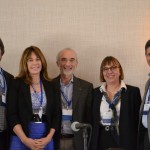MCWRA and Partners Take Watershed Management Interests to Southern California
Urban Water Institute, Spring Conference 2014, Palm Springs, CA
By: Lisa Ohland, Chair, Urban Water Institute
Pictures from the Gallery
Picture on right – L-R: John Kingsbury, Executive Director, MCWRA; Lisa Ohland, Chair, Uuban Water Institute; Dr. Martha Conklin, UC Merced; Dr. Roger Bales, UC Merced; Jim Branham, Executive Director, Sierra Nevada Conservancy
The UWI’s Spring Conference theme of “Water: The Future is Now!” was epitomized in the opening session with the Mountain Counties’ Futuristic Watershed Management panel. Moderator John Kingsbury, Executive Director of the Mountain Counties Water Resources noted that 40 percent of the state’s water – around 17 million acre-feet of runoff – originates in the mountain counties. Panel members Dr. Roger C. Bales, Dr. Martha Conklin of the University of California, Merced and Jim Branham, Executive Director of the Sierra Nevada Conservancy discussed advanced watershed management principles, with one of the most intriguing being the UC Merced research showing how the selective culling of trees through forest management could increase the water stored in the mountains. When densely treed forests form a canopy of branches that don’t allow snow and rainfall to penetrate, the interception of snowfall in the canopy causes increased evaporation loss from solar forces. If trees were selectively culled to allow penetration of the canopy, the professors estimated (from their pilot program) that increased runoff of between 9-16% could be achieved. This concept was new and intriguing to the urban water community and several questions were asked regarding how to move this concept forward amongst the appropriate stakeholders.
Nicole Sandkulla, General Manager of the newly formed Bay Area Water Supply & Conservation Agency (BAWSCA) spoke about the innovative legislative approach to achieving supply reliability taken by the agencies served by the City of San Francisco’s Public Utility District (SFPUD) in her presentation, “Bay Area Innovation – What’s New in Northern California Water?” SFPUD owns and operates the Hetch Hetchy regional water system that was originally constructed in 1937. Twenty-four (24) agencies (including San Jose, all of the Peninsula cities, Oakland, Berkeley and several other East Bay cities and water agencies) are reliant upon contracts with SFPUD for their entire water supply – they have no ownership position in the system and no say in its costs or operation. In the early 2000s, after unsuccessfully trying to convince SFPUD to commence an assessment and rebuilding of the then failing system, BAWSCA was formed initially as a voluntary association that successfully lobbied the state legislature to force SFPUD into adopting a $4.6 billion repair, rehabilitation and replacement program. Despite the improvements and increased reliability that have been achieved due to this program, SFPUD will not provide any additional water over what they provide now and can shut-off San Jose and Santa Clara without notice. BAWSCA again sought legislative support and was re-created as a public agency that can acquire water, coordinate water conservation and recycling activities, finance projects and build facilities jointly with other local agencies or on its own.
Metropolitan Water District of Southern California Business & Technology Manager Roy Wolfe showcased “Innovation & Water – Where is the Cutting Edge?” – a panel comprised of seven firms that are in various stages of impacting the future of water and wastewater delivery. From Dr. Greg Quist’s Hadronex system that senses wastewater overflows at manholes and alerts operators before an spill (currently available), to the Water Research Foundation’s “Targeted Collaborations” in forward and reverse osmosis, IDEXX rapid coliform tests and micro turbines (currently available), to Bill Kelly/Isle, Inc.’s work testing a patented UV reflector that increases UV performance (coming soon) and “TrunkMinder” – an automated continuous monitoring system for leaks in larger diameter pipelines (coming soon) – it was clear that the future looks bright . Also discussed were small hydro projects that can be placed in pipelines as small as 8” to recover energy from the gravity flow of water, and solar installations on reservoir roofs that supplied ¼ to ½ of the energy requirements of an Orange County water agency pump station.
The concept of mining underground supplies in remote areas was discussed in the panel, “New Water – Is Cadiz Part of the Answer?” Representatives of Cadiz Water and the Santa Margarita Water District (SMWD) discussed the geological and environmental aspects of the proposed two-phase Cadiz water program: Phase I which would capture an average of 50,000 AFY of water (for 50 years) from a wellfield on the Cadiz property (near Fenner Valley and Orange Blossom Wash in the eastern Mojave Desert) and deliver it via a pipeline to the Colorado River Aqueduct near Twenty-Nine Palms, California to users throughout Southern California; Phase II would use the available capacity to store up to 1 MAF of imported water. Only Phase I has been reviewed through CEQA. As of the end of 2013, 80% of the Project’s water supplies are under option or committed under purchase agreement; participants include SMWD, Three Valleys Municipal Water District, Suburban Water Systems, Golden State Water Company, Jurupa Community Services and California Water Service Company.
Kevin Kelley, General Manager of the Imperial Irrigation District presented “Will Geothermal be the Solution for the Salton Sea?” IID’s proposal would use fees charged for geothermal power to restore and enhance the Salton Sea. While the fluid geothermal resources at the Salton Sea are significant, they are stymied by two problems: 1) there are no nearby transmission lines to transfer the power to the electrical grid and 2) the cost of initial development is slightly higher than solar power – however unlike solar or wind power, geothermal is baseline (continuous) power that is uninterrupted by lack of sun or wind.
 And finally, one of the highlights of the conference was a keynote address by UWI Lifetime Achievement Award recipient, Pat Mulroy, the retiring chief of the Southern Nevada Water Authority – the “Vegas Water Czar” as she was named by the New York Times. Ms. Mulroy spoke about the growing scarcity of water in the west, and how all water systems are interrelated – that what happens in the Bay Delta will affect the residents of Las Vegas as surely as what happens in the Rocky Mountains. She noted that we will not litigate our way out of these shortages, but rather, need flexible and adaptive management ability – along with a lot of good will – in order to continue to provide reliable water service to urban and agricultural communities while minimizing the effect on the environment.
And finally, one of the highlights of the conference was a keynote address by UWI Lifetime Achievement Award recipient, Pat Mulroy, the retiring chief of the Southern Nevada Water Authority – the “Vegas Water Czar” as she was named by the New York Times. Ms. Mulroy spoke about the growing scarcity of water in the west, and how all water systems are interrelated – that what happens in the Bay Delta will affect the residents of Las Vegas as surely as what happens in the Rocky Mountains. She noted that we will not litigate our way out of these shortages, but rather, need flexible and adaptive management ability – along with a lot of good will – in order to continue to provide reliable water service to urban and agricultural communities while minimizing the effect on the environment.

